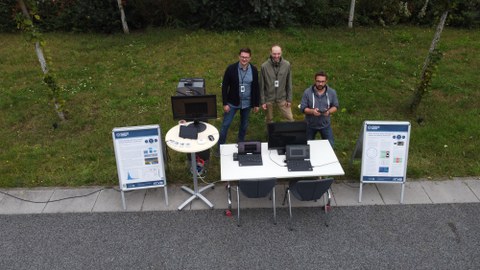Sep 27, 2021
Demonstrators at the ICL 2021

Smart Parking Demo Setup
This year's ICL Conference was dedicated to the topic "Mobility for Smart Cities and Regional Development - Challenges for Higher Education" and was organized, among others, by the Chair of Information Technology Transport Systems in Dresden. As part of the conference, a technical workshop was held, which presented demonstrators of current developments in the field of networked and intelligent mobility of the future.
Demo A: Smart Parking
The shown demonstration addresses the active and passive positioning in intelligent traffic systems with the focus on indoor applications. Radio-based positioning in a Wireless Sensor Network (WSN) and radar-based occupancy detection of parking spaces are demonstrated. This forms the sensor technology basis for future smart parking systems.
The positioning of the vehicles is carried out by an Ultra-wideband (UWB) Real Time Localization System (RTLS) with the help of time-of-flight measurements of radio signals in a WSN. The position of a vehicle equipped with a corresponding sensor is determined in real time and passed on to the parking management system.
The second component of the demonstration is the radar-based occupancy detection of parking lots in order to navigate the vehicle to a free parking lot. The sensor used here is a UWB radar, which passively evaluates the reflections from a parked vehicle for occupancy detection. In the future, pure communication signals from a WSN will be used for detection by evaluating the multipath information of the channel (Radio Sensing).
Smart Parking
Demo B: Platooning
Nowadays, the development of autonomous vehicles is undoubtedly an important topic in the automotive industry. Manufacturers and policymakers are hoping for many benefits from the new technology, including increased traffic efficiency, safety and driving comfort. Platooning already represents an important application scenario for autonomous driving. The system takes control over the lateral and longitudinal guidance of a vehicle and adjusts it according to the traveled trajectory of a lead vehicle, taking into account the safety distance and correct lane.
The control of the system is implemented by a cascaded controller. The inner controller is a Model Predictive Controller (MPC), which calculates the required steering angle and acceleration. The outer controller is a Proportional-Integral-Differential (PID) controller, which performs the implementation and control of the calculated variables with the inclusion of the vehicle's actuators. The real-time position data of two vehicles are measured by a GNSS receiver with a highly accurate Real Time Kinematic (RTK) system. Communication between the vehicles is performed by WLANp technology using a standardized ITS-G5 CAM message with a frequency of 10 Hz and an on-board unit (OBU) in the vehicles.
Platooning
